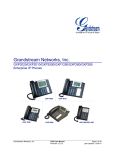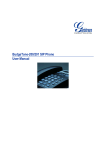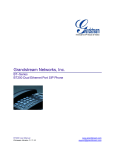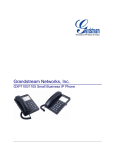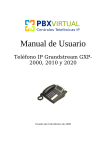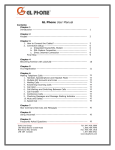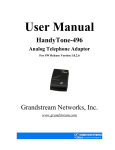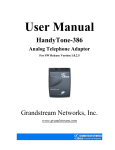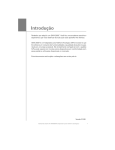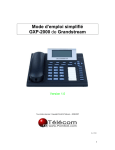Download User Manual
Transcript
Grandstream Networks, Inc. GXP-2000 User Manual User Manual GXP-2000 Enterprise IP Phone For Firmware Version 1.0.1.9 Grandstream Networks, Inc. www.grandstream.com -1- Grandstream Networks, Inc. GXP-2000 User Manual Table of Contents 1 WELCOME -4- 2 INSTALLATION -5- 2.1 2.2 2.3 2.4 2.5 3 -5-5-6-6-7- PRODUCT OVERVIEW 3.1 3.2 4 WHAT IS INCLUDED IN THE PACKAGE CONNECTING YOUR PHONE WALL MOUNT SAFETY COMPLIANCES WARRANTY -8- KEY FEATURES HARDWARE SPECIFICATION -9- 10 - USING GXP-2000 IP PHONE - 11 - 4.1 GETTING FAMILIAR WITH LCD 4.2 GETTING FAMILIAR WITH KEYPAD 4.3 MAKING AND ANSWERING PHONE CALLS 4.3.1 Handset, Speakerphone and Headset Mode 4.3.2 Multiple SIP Accounts and Lines 4.3.3 Making Calls 4.3.4 Making Calls using IP Address 4.3.5 Receiving Calls 4.3.6 Call Hold 4.3.7 Call Waiting and Switch between Calls 4.3.8 Call Transfer 4.3.9 3-Way Conferencing 4.3.10 Checking Message and Message Waiting Indication 4.3.11 Mute and Delete 4.3.12 Speed Dial 4.4 CALL FEATURES 5 CONFIGURATION GUIDE - 11 - 12 - 14 - 14 - 14 - 15 - 15 - 17 - 17 - 17 - 17 - 18 - 18 - 18 - 18 - 20 - 21 - 5.1 CONFIGURATION WITH KEYPAD 5.2 CONFIGURATION WITH WEB BROWSER 5.2.1 Access the Web Configuration Menu 5.2.2 End User Configuration 5.2.3 Advanced User Configuration 5.2.4 Saving the Configuration Changes 5.2.5 Rebooting the Phone from Remote 5.3 CONFIGURATION THROUGH CENTRAL PROVISIONING SERVER -2- - 21 - 24 - 24 - 24 - 28 - 37 - 38 - 38 - Grandstream Networks, Inc. GXP-2000 User Manual 6 FIRMWARE UPGRADE 6.1 6.2 7 - 40 - UPGRADE THROUGH HTTP UPGRADE THROUGH TFTP - 40 - 40 - RESTORE FACTORY DEFAULT SETTING -3- - 42 - Grandstream Networks, Inc. GXP-2000 User Manual 1 Welcome Thank you for purchasing Grandstream award-winning GXP-2000 Enterprise IP Phone. You made an excellent choice and we hope you will enjoy all its capabilities. Grandstream's award-wining GXP-2000 SIP IP phone is the innovative enterprise IP telephone that offer a rich set of functionality and superb sound quality. They are fully compatible with SIP industry standard and can interoperate with many other SIP compliant devices and software on the market. Grandstream GXP-2000 has been awarded the Best of Show product in 2005 Internet Telephony Conference and Expo. This document is subject to changes without notice. The latest electronic version of this user manual is available for download from the following location: http://www.grandstream.com/user_manuals/GXP2000.pdf -4- Grandstream Networks, Inc. GXP-2000 User Manual 2 Installation 2.1 What is Included in the Package The GXP-2000 phone package contains: 1) 2) 3) 4) 5) One GXP-2000 Main Case One Handset One Phone Cord One Universal Power Adaptor One Ethernet Cable 2.2 Connecting Your Phone Following is a backside picture of GXP-2000, each connection port is labeled with the name in the following table: EXT PC LAN+PoE POWER HEADSET The table below describes the connectors on the GXP-2000 phone: EXT Extension connection for extended keypad(will be implemented in the future) -5- Grandstream Networks, Inc. GXP-2000 User Manual LAN/PoE PC POWER HEADSET 10/100 Switch LAN port for connecting to Ethernet. Support PoE (802.3af). Draws power from both spare line and signal line 10/100 Switch port for connecting PC 5V power port 3.5mm Headset port 2.3 Wall Mount GXP-2000 can be wall mounted. There are two wall mount holes on the bottom of the GXP-2000 main body: Top Wall Mount hole Bottom Wall Mount hole User can simply place the device against the wall with two holes placed to the fixed hanger position on the wall. Handset Rest Tab Tab with extension down Tab with extension up After wall mounting the main body of GXP-2000, user will need to pull out the tab (extension downward) from handset cradle on the top of the handset rest, and rotate the tab and plug it into the slot with the extension up for handset holding. 2.4 Safety Compliances The GXP-2000 phone is compliant with various safety standards including FCC/CE. Its power adaptor is compliant with UL standard. The phone should only be operated with the universal power adaptor provided with the package. Damages to the phone caused by using other unsupported power adaptors are not covered by the manufacturer’s warranty. -6- Grandstream Networks, Inc. GXP-2000 User Manual 2.5 Warranty Grandstream has a reseller agreement with our reseller customer. End user should contact the company from whom you purchased the product for replacement, repair or refund. If you purchased the product directly from Grandstream, contact your Grandstream Sales and Service Representative for a RMA (Return Materials Authorization ) number. Grandstream reserves the right to remedy warranty policy without prior notification. Warning: Please do not attempt to use a different power adaptor. Using other power adaptor may damage the GXP-2000 and will void the manufacturer warranty. Caution: Changes or modifications to this product not expressly approved by Grandstream, or operation of this product in any way other than as detailed by this User Manual, could void your manufacturer warranty. Information in this document is subject to change without notice. No part of this document may be reproduced or transmitted in any form or by any means, electronic or mechanical, for any purpose without the express written permission of Grandstream Networks, Inc.. -7- Grandstream Networks, Inc. GXP-2000 User Manual 3 Product Overview GXP-2000 series IP phone is designed to be an enterprise telephone, which could also be used in general household. The following photo illustrates the appearance of a GXP-2000 IP phone. Front View Back View -8- Grandstream Networks, Inc. GXP-2000 User Manual 3.1 Key Features Grandstream GXP-2000 IP Phone is a next generation enterprise IP telephone based on industry open standard SIP (Session Initiation Protocol). Built on innovative technology, Grandstream IP Phone features market leading superb sound quality and rich functionalities at mass-affordable price. Software Feature: • • • • • • • • • • • • • • • Support SIP 2.0, TCP/UDP/IP, PPPoE, RTP/RTCP, HTTP, ARP/RARP, ICMP, DNS, DHCP, NTP/SNTP, TFTP, SIMPLE/PRESENCE protocols Support multiple SIP accounts and up to 11 media channels concurrently Support multiparty conferencing Support NAT traversal using IETF STUN and Symmetric RTP Advanced Digital Signal Processing (DSP) technology to ensure superior hi-fidelity audio quality, interoperable with various 3rd party SIP end user device, Proxy/Registrar/Server and Gateway products Advanced and patent pending adaptive jitter buffer control, packet delay and loss concealment technology Support popular codecs including G711 (a-law and u-law), G722, G.723.1 (5.3K/6.3K), G.726 (40K/32K/24K/16K), G.728, G.729A/B, GSM and iLBC. Dynamic negotiation of codec and voice payload length Support standard voice features such as Caller ID Display or Block, Call Waiting, Call Waiting Caller ID, Call Hold, Call Transfer (attended/blind), Do-Not-Disturb, Call Forwarding, in-band and out-of-band DTMF(RFC2833), SIP INFO, Dial Plans, Off-Hook Auto Dial, Auto Answer, Early Dial and Speed Dial, etc. Full duplex hands-free speakerphone, redial, call log, volume control, voice mail with indicator, downloadable ring tone, etc. Support Silence Suppression, VAD (Voice Activity Detection), CNG (Comfort Noise Generation), Line Echo Cancellation (G.168) and AGC (Automatic Gain Control) Support DIGEST authentication and encryption using MD5 and MD5-sess Provide easy configuration through manual operation (phone keypad), Web interface or automated provisioning by downloading encrypted configuration file via HTTP/TFTP for mass deployment Support for Layer 2 (802.1Q VLAN, 802.1p) and Layer 3 QoS (ToS, DiffServ, MPLS) Support firmware upgrade via TFTP or HTTP. Support DNS SRV Look up and SIP Server Fail Over Hardware Feature: • • • Graphic LCD that can display 64(rows) x 131 (columns) in pixels Support up to 11 line calls and 7 speed dial keys. (Current firmware support 4 line with 7 speed dial keys) Support Power over Ethernet (PoE) IEEE standard 802.3af, power can be drawn from either spare line or data line. Note: GXP-2000 will use power from power adapter whenever it is plugged in. -9- Grandstream Networks, Inc. GXP-2000 User Manual • • • Support Headset which will auto switch to Headset when plugged in Support 10/100 Full/Half Duplex Ethernet Switch with LAN and PC port, Ethernet polarity can be auto detected, thus either straight through or twist cable can be used. Support Message Waiting Indication LED 3.2 Hardware Specification The table below describes the hardware specification of GXP-2000: Model GXP-2000 LAN interface Power over Ethernet 2xRJ45 10/100Base-T with PoE (802.3af) IEEE 802.3af standard, can draw power from both spare lines or signal lines from Ethernet 3.5mm Headset port 11 LED with different light pattern in RED color Input: 100-240VAC 50-60 Hz Output: +5VDC, 1200mA, UL certified 215mm (W) 220mm (D) 57mm (H) 0.82kg (1.8lbs) 40 - 130oF 5 – 45oC 10% - 90% (non-condensing) FCC / CE / C-Tick Pending Headset Jack LED Universal Switching Power Adaptor Dimension Weight Temperature Humidity Compliance - 10 - Grandstream Networks, Inc. GXP-2000 User Manual 4 Using GXP-2000 IP Phone 4.1 Getting Familiar with LCD GXP-2000 phone has a numeric LCD of 64(rows) x 131 (columns) in pixels. Here is the display when all segments illuminate: The LCD is equipped with a backlight. When the phone is configured properly and in the normal idle state, the backlight is off. Whenever an event occurs, the backlight turns on automatically and brings the user’s attention. Icon LCD Icon Definitions Network Status Icon: FLASH in the case of Ethernet link failure OFF if IP address or SIP server is not found ON if IP address and SIP server are located Phone Status Icon: OFF when the handset is on-hook ON when the handset is off-hook Speaker Phone Status Icon: FLASH when phone rings or a call is pending OFF when the speakerphone is off ON when the speakerphone is on Handset, Speakerphone and Ring Volume Icon: 0-7 scales to adjust handset / speakerphone / ring volume - 11 - Grandstream Networks, Inc. GXP-2000 User Manual Real-time Clock: Synchronized to Internet time server Time zone configurable via web browser AM PM Time Icon: AM for the morning PM for the afternoon 4.2 Getting Familiar with Keypad Message Waiting Indicator Line 1-4 Keys Menu Keys Speed Dial / Configurable line indicators Mute/Delete Message Conference Transfer Hold Speaker Send/Re-Dial - 12 - Standard Keypad Grandstream Networks, Inc. GXP-2000 User Manual GXP-2000 phone has 35 key buttons: Key Button Key Button Definitions LINE1-LINE4 4 Line keys with LED, can be extended to 11 Lines with the use of 7 Speed Dial Keys on the right SPEED DIAL/ EXTENDED LINE 7 Speed dial keys with LED that can be configured to use for LINE calls as well UP ↑ Next Menu item when phone is in MENU mode Or reduce handset/speakerphone volume when phone is ACTIVE Or reduce ring volume when phone is in IDLE mode DOWN ↓ Previous Menu item when phone is in MENU mode Or increase handset/speakerphone volume when phone is ACTIVE Or increase ring volume when is in IDLE mode LEFT Å Shift cursor to left RIGHT Æ Shift cursor to right MENU ● Enter MENU mode when phone is in IDLE mode. It is also the ENTER key once entering MENU TRNF Transfer an ACTIVE call to another number CONF Bring Calling/Called party into conference MSG Enter to retrieve voice mails or other messages MUTE/DEL HOLD SPEAKER SEND 0 - 9, *, # Mute an ACTIVE call; or Delete a key entry, call log, voice mail and etc Temporarily hold an ACTIVE call Enter hands-free mode Dial a new number or Redial the last number dialed. After entering the phone number, pressing this key would force a call to go out immediately before timeout 12 standard Digit, * and # keys are usually used to make phone calls - 13 - Grandstream Networks, Inc. GXP-2000 User Manual 4.3 Making and Answering Phone Calls 4.3.1 Handset, Speakerphone and Headset Mode Handset can be switched with either Speaker or Headset, however, whenever the Headset is plugged in, Speaker will be switched to Headset. To Switch between Handset and Speaker/Headset, simply press the Hook Flash in the Handset cradle. 4.3.2 Multiple SIP Accounts and Lines GXP-2000 can support up to 4 independent SIP accounts. Each account is capable of independent SIP Server, user and NAT settings among others. GXP-2000 supports up to 11 concurrent audio channels arbitrarily assigned to these SIP accounts -- they can be used in any combination as long as the server allows it. Speed dial numbers configured must be associated to a specific SIP account. Each of the 4 LINE buttons (LINE1-LINE4) is “virtually” mapped to each SIP account. In offhook state, when user chooses an idle line, the name of the account (as configured in the web interface) will be displayed in the LCD while a dial tone is being played out. For example, if the 4 SIP accounts are named FWD, SIPPHONE, BROADVOICE, and PBX respectively and they are all active and registered. When LINE1 is pressed, user will hear dial tone and see “FWD”. When LINE2 is pressed, user will hear dial tone and see “SIPPHONE”. When LINE3 is pressed, user will hear dial tone and see “BROADVOICE”. When LINE4 is pressed, user will hear dial tone and see “PBX”. For outgoing calls, GXP-2000 will pick up the LINE pressed, which will be lit up in solid red color. User can switch the dialing account before dialing any digits by pressing the same LINE button one or more times. If user continues to press one LINE, the selected account will circulate among the registered accounts. For example, when LINE1 is pressed, LCD displays “FWD”. If LINE1 is pressed again, LCD displays “SIPPHONE” and the subsequent call will be made through SIP account 2. For incoming calls, if an account is configured and registered, all incoming calls for that account will attempt to use its corresponding LINE if it is not in use. When the “virtually” mapped line is in use, GXP-2000 will flash the next available LINE (from Left to Right, then Top to Bottom) in red color. LINE 5 to 11 cannot be picked like LINE 1 to 4. This happens automatically. When an incoming call arrives while all of the 4 LINE (1-4) channels are in use, LINE5 will be selected. When all 4 LINE (14) channels are in use, and user places an active call on hold, user can on-hook and off-hook to activate the next available channel (LINE5 or whatever the next one). When any one of the 7 functions keys are associated with a call, they function as LINE keys; otherwise they function as speed dial keys. (So when LINE 5 is in use, you cannot use speed dial 1, but speed dial 2-7 still work). A LINE is defined as “ACTIVE” when it is making or receiving a call, and its corresponding LINE LED is lit up in solid RED. - 14 - Grandstream Networks, Inc. GXP-2000 User Manual 4.3.3 Making Calls There are three ways to make phone calls: 1. Make Handset/SPEAKER/Headset off hook, or press the available LINE key to select a SIP account, the corresponding LINE LED will light up in solid red. Enter the phone numbers and press the SEND key. 2. Make Handset/SPEAKER/Headset off hook, or press the available LINE key, the corresponding LINE LED will light up in solid red. Press the SEND button to redial the last number called. 3. Make Handset/SPEAKER/Headset off hook, or press the available LINE key, the corresponding LINE LED will light up in solid red. Press the Speed Dial key to call the preset calling party number. Note: • Once pressed, the dialed number is displayed on the LCD as the corresponding DTMF tone is played out. • If the “SEND” button is not pressed after the phone number, the phone will wait for 4 seconds before initiating the call. 4.3.4 Making Calls using IP Address Direct IP calling allows two phones to talk to each other in an ad hoc fashion without a SIP proxy. VoIP calls can be made between two phones if • • • Both phones have public IP addresses, or Both phones are on a same LAN using private or public IP addresses, or Both phones can be connected through a router using public or private IP addresses. To make a direct IP calling, first pick up the phone or turn on the speakerphone, then press “Menu” button followed by the 12-digit target IP address. If there is a user part, press “Menu” button and then the encoded user part, followed by *3 (encoding for “@”) and then followed by the 12-digit target IP address. Destination ports can also be specified using *4 (encoding for “:”) followed by the encoded port number. The follow is a table of the encoding scheme for the most commonly used characters: Input 00 01 02 03 Encoding 0 1 2 3 - 15 - Grandstream Networks, Inc. GXP-2000 User Manual 04 05 06 07 08 09 *0 *1 *2 *3 *4 21 22 23 31 32 33 41 42 43 51 52 53 61 62 63 71 72 73 74 81 82 83 91 92 93 94 4 5 6 7 8 9 . (dot character) _ (underscore character) - (hyphen character) @ : (column character) A B C D E F G H I J K L M N O P Q R S T U V W X Y Z The rule of thumb to remember these encoding is: “a” is the first letter on button “1” so its encoding is “11”. “b” is the 2nd letter on button “1” and its encoding is “12”. “c” is the 3rd letter on button “1” and its encoding is “13”. Likewise, “d” is the first letter on button “2” and its encoding is “21”. This pattern and rule apply to all other alphabetic encoding. Examples: If the target IP address is 192.168.0.160, the dialing convention is Menu_key 192168000160 - 16 - Grandstream Networks, Inc. GXP-2000 User Manual followed by pressing the “(Re)Dial” button or the “#” key is it is configured as a send key. In this case, the default destination port 5060 is used if no port is specified. If the target IP address/port is 192.168.1.20:5062, the dialing convention would be: Menu_key 192168001020*45062 followed by pressing the “SEND(Re)Dial” button or the “#” key is it is configured as a send key. If the target address is [email protected]:5062, the dialing convention would be: Menu_key 51634262*3192168001100*45062 followed by pressing the “SEND/(Re)Dial” button or the “#” key is it is configured as a send key. 4.3.5 Receiving Calls There are two states when GXP-2000 receives a call: 1. When receiving an initial call. Besides ringing with selected Ring Tone, the corresponding account LINE will flash in red, taking Handset/SPEAKER/Headset off hook will enable user to hear the calling party in Handset/SPEAKER/Headset. 2. When receiving second or more incoming calls, besides playing stutter Call Waiting tone, GXP-2000 will pick up the corresponding account LINE or the next available LINE as described in section 4.3.2. 4.3.6 Call Hold While in conversation, pressing the “HOLD” button will put the other party on hold. User can resume the conversation by pressing the corresponding LINE. User will also automatically put the current line on “HOLD” by pressing another available LINE for making or receiving other phone calls. 4.3.7 Call Waiting and Switch between Calls GXP-2000 can support up to 11 Lines, user can switch to another line for making or answering calls and automatically put an ACTIVE call on Hold. When receiving second or more incoming calls, besides playing a stutter Call Waiting tone, GXP-2000 will pick up the corresponding account or the next available LINE as described in section 4.3.2. 4.3.8 Call Transfer GXP-2000 supports both BLIND and ATTENDED Transfer: 1. Blind Transfer: When a LINE is “ACTIVE”, user will get a dial tone by pressing the “TRNF” button, then dial the number and press the “SEND” button, this will transfer the other party in the corresponding LINE to the dialed number. - 17 - Grandstream Networks, Inc. GXP-2000 User Manual 2. Attended Transfer: When in conversation with an “ACTIVE” LINE as defined in section 4.3.2, user shall press “TRNF” button, then press the intended LINE that is on “HOLD”. If there is no LINE on HOLD, user will need to make a call and thus automatically puts the current ACTIVE LINE on HOLD. Note: • Transferring calls across SIP domains needs to be supported by SIP services. 4.3.9 3-Way Conferencing GXP-2000 supports 3-way conferencing. With one LINE ACTIVE and another LINE on HOLD, press the CONF button then the LINE that is on HOLD will join the three parties together in a conference. If after pressing the “CONF” button, a user decides not to conference anyone, user can cancel it and resume the conversation by pressing CONF or the original LINE button. If the conference holder wishes to end a conference, simply press HOLD, which breaks the conference and places both parties on hold. User can then talk to each individual party by selecting the corresponding LINE. 4.3.10 Checking Message and Message Waiting Indication When GXP-2000 is on-hook, pressing the MSG button will trigger the phone to call the VM Server (VMS) configured for the primary account. If a line/account is selected first, it dials the VMS configured for that account. The MWI (Message Waiting Indicator) LED will flash in red color in three quarters of a second when voicemail server sends message waiting information to GXP-2000. 4.3.11 Mute and Delete When in conversation with an ACTIVE LINE, pressing “MUTE/DEL” will mute the conversation, that is, you can hear the other party but the other party cannot hear you. Pressing the button again will resume the conversation. When dialing a number, press “MUTE/DEL” will delete the last entered digit. 4.3.12 Speed Dial There are 7 speed dial buttons, each can be configured with a different account to dial. A vertical rectangle pad on the keypad is provided to label Speed Dial numbers. - 18 - Grandstream Networks, Inc. GXP-2000 User Manual When an incoming call arrives while all of the 4 LINE (1-4) channels are in use, the speed dial buttons will be selected as LINE indicators. When any one of the 7 functions keys are associated with a call, they function as LINE keys; otherwise they function as speed dial keys. (So when LINE 5 is in use, you cannot use speed dial 1, but speed dial 2-7 still work). - 19 - Grandstream Networks, Inc. GXP-2000 User Manual 4.4 Call Features GXP-2000 series phone supports a list of call features: Caller ID Block (or Anonymous Call), Disable/Enable Call Waiting, Call Forward on Busy, Delay, or Unconditional, etc. Following table shows the call features of GXP-2000 series phone. Key *30 *31 *67 *82 *70 *71 *72 *73 *90 *91 *92 *93 Call Features Block Caller ID (for all subsequent calls) Send Caller ID (for all subsequent calls) Block Caller ID (per call) Send Caller ID (per call) Disable Call Waiting. (Per Call) Enable Call Waiting (Per Call) Unconditional Call Forward To use this feature, dial “*72” and get the dial tone. Dial the forward number and “#” for a dial tone, then hang up. Cancel Unconditional Call Forward To cancel “Unconditional Call Forward”, dial “*73” and get the dial tone, then hang up. Busy Call Forward To use this feature, dial “*90” and get the dial tone. Dial the forward number and “#” for a dial tone, then hang up. Cancel Busy Call Forward To cancel “Busy Call Forward”, dial “*91” and get the dial tone, then hang up. Delayed Call Forward To use this feature, dial “*92” and get the dial tone. Dial the forward number and “#” for a dial tone, then hang up. Cancel Delayed Call Forward To cancel this Forward, dial “*93” and get the dial tone, then hang up. - 20 - Grandstream Networks, Inc. GXP-2000 User Manual 5 Configuration Guide 5.1 Configuration with Keypad When the phone is on-hook, press the MENU button to enter MENU mode. When the phone goes offhook or a call comes in, the phone automatically exits the MENU state and prepares for the call. It also exits the MENU state if left idle for 20 seconds. Here are the Menu options supported: Menu Item Menu Functions 1 Display “[1] DO-NOT-DISTURB Off” Press Menu to enter edit mode “-- enable DND” or “-- disable DND” for the current selection Press ‘↓’ or ’↑’ to toggle the selection Press Menu to save and exit 2 Display “[2] DHCP/PPPoE Mode” Press Menu to enter edit mode “-- enable DHCP Mode” or “-- disable DHCP Mode” for the current selection Press ‘↓’ or ’↑’ to toggle the selection Press Menu to save and exit Must recycle power to take effect 3 Display “[3] IP Address” Press Menu to display the current IP address Enter new IP address if DHCP is OFF Press ‘↓’ or ’↑’ to exit Press Menu to (save and) exit Must recycle power to take effect 4 Display “[4] Subnet Mask” Press Menu to display the Subnet address Enter new Subnet address if DHCP is OFF Press ‘↓’ or ’↑’ to exit Press Menu to (save and) exit Must recycle power to take effect - 21 - Grandstream Networks, Inc. GXP-2000 User Manual Menu Item Menu Functions 5 Display “[5] Default Gateway” Press Menu to display the Router/Gateway address Enter new Router/Gateway address if DHCP is OFF Press ‘↓’ or ’↑’ to exit Press Menu to (save and) exit Must recycle power to take effect 6 Display “[6] DNS Server” Press Menu to display the DNS address Enter new DNS address if DHCP is OFF Press ‘↓’ or ’↑’ to exit Press Menu to (save and) exit Must recycle power to take effect 7 Display “[7] TFTP Server” Press Menu to display the TFTP address Enter new TFTP server address Press ‘↓’ or ’↑’ to exit Press Menu to save and exit 8 Display “[8] G-711u 2” Press Menu to select new codec Press ‘↓’ or ’↑’ to browse a list of available codecs line 1 “ - G-711A 2” 2 “ - G-722 2” 3 “ - G-723 1” 4 “ - G-726 2” 5 “ - G-728 8” 6 “ - G-729 2” 7 “ - iLBC 1” Press 1 to 9 to indicate number of frames per TX packet Press Menu to save and exit. The codec selected takes effect immediately. 9 Display “[9] SIP Svr1” Press Menu to display the SIP Server/Service Provider Press ‘↓’ or ’↑’ to browse the valid SIP Server (1-4) Press Menu to save and exit SIP Server(s) must be configured via Web browser Only configured SIP server(s) are displayed Take effect immediately - 22 - Grandstream Networks, Inc. GXP-2000 User Manual Menu Item Menu Functions 10 Display “[10] Firmware Version” Press Menu to display the code releases Press ‘↓’ or ’↑’ to browse line 1 “b 2005-03-15” – date: boot code 2 “ 1. 0. 0.3” – version: boot code 3 “P 2005-03-15” – date: phone code 4 “ 1. 0. 0. 3” – version: phone code 5 “1st 2004-05-12” – date: 1st ring tone 6 “ 1. 0. 0. 0” – version: ring tone 7 “2nd 2004-05-12” – date: 2nd ring tone 8 “ 1. 0. 0. 0” – version: ring tone 9 “3rd 0000-00-00” – date: 3rd ring tone 10 “ 0. 0. 0. 0” – version: ring tone (all zeroes means unavailable or unsupported) Press Menu to exit, take effect immediately 11 Display “[11] MAC Address” Press Menu to display the physical / MAC address Press Menu, ‘↓’ or ’↑’ to exit 12 Display “[12] Ring 0” Press Menu to hear the selected ring tone, press ‘↓’ or ’↑’ to select the stored ring tones. Now only 3 are available, ring 0 (default), ring 1 and ring 2. ring 3 is unavailable or unsupported. Press Menu to select and exit, take effect immediately 15 - RESET - Display “[15] Diagnostic Mode” Press Menu to enter this mode, all LEDs will light up Press any key on the keypad, the button name will be displayed in the LCD. Lift and put back the handset to exit the diagnostic mode. Display “ – RESET --”, please be very CAREFUL here • Press Menu without key in anything, phone will function the same as power cycle / reboot • Key in the physical / MAC address on back of the phone, Press Menu, phone will be reset back to FACTORY DEFAULT setting, all your setting will be erased. Please refer to Section 7 for complete details. - 23 - Grandstream Networks, Inc. GXP-2000 User Manual Menu Item Others Menu Functions When phone is powered on and time is displayed • Press ‘↓’ or ’↑’, Display “ ring [4] ”, press ‘↓’ or ’↑’ again to hear and adjust the ring tone volume, from 0 (off) to 7 (maximum), to designed one, then off and on the handset to set the ring tone volume • Press “SPEAKER” button, or off hook and pick up handset, press ‘↓’ or ’↑’ to adjust the speakerphone or phone volume 5.2 Configuration with Web Browser GXP-2000 series IP phone has an embedded Web server that will respond to HTTP GET/POST requests. It also has embedded HTML pages that allow a user to configure the IP phone through a Web browser such as Microsoft’s IE. 5.2.1 Access the Web Configuration Menu The IP Phone Web Configuration Menu can be accessed by the following URI: http://Phone-IP-Address where the Phone-IP-Address is the IP address of the phone. There are two ways to retrieve this IP address from the phone: 1) When the phone is on-hook , press Menu button and then the browsing arrow keys to check “[3] IP Address” 2) When the phone is off-hook or in speakerphone mode, press Menu button NOTE: • To type IP address into browser to get into the configuration page, please strip out the leading “0” as the browser will parse in octet. e.g.: if the IP address is: 192.168.001.014, please type in: 192.168.1.14. 5.2.2 End User Configuration Once this HTTP request is entered and sent from a Web browser, the GXP-2000 will respond with the following login screen: Grandstream Device Configuration - 24 - Grandstream Networks, Inc. GXP-2000 User Manual Password Login All Rights Reserved Grandstream Networks, Inc. 2004 The password is case sensitive with maximum length of 25 characters and the factory default password for End User is “123”. After a correct password is entered in the login screen, the embedded Web server inside the GXP-2000 will respond with the Configuration page which is explained in details below. Grandstream Device Configuration STATUS BASIC SETTINGS ADVANCED SETTINGS End User Password: IP Address: ACCOUNT 1 ACCOUNT 2 ACCOUNT 3 ACCOUNT 4 (purposely not displayed for security protection) dynamically assigned via DHCP (default) or PPPoE (will attempt PPPoE if DHCP fails and following is non-blank) PPPoE account ID: PPPoE password: Preferred DNS server: 0 . 0 . 0 0 . statically configured as: IP Address: 192 . 168 . 1 . 11 Subnet Mask: 255 . 255 . 255 . 0 Default Router: 192 . 168 . 1 . 1 DNS Server 1: 19 . 105 . 5 . 1 DNS Server 2: 24 . 127 . 198 . 4 Speed Dial 1: Name: John Doe UserID: 6170612 Account: Account 2 Speed Dial 2: Name: UserID: Account: Account 2 Speed Dial 3: Name: UserID: Account: Account 2 - 25 - Grandstream Networks, Inc. GXP-2000 User Manual Speed Dial 4: Name: UserID: Account: Account 1 Speed Dial 5: Name: UserID: Account: Account 1 Speed Dial 6: Name: UserID: Account: Account 1 Account: Account 1 Speed Dial 7: Name: UserID: GMT-6:00 (US Central Time, Chicago) Time Zone: Daylight Savings No Time: normal time) LCD Backlight No Always On: Time Display Format: Date Display Format: Yes (if set to Yes, display time will be 1 hour ahead of Yes 12 HOUR 24 HOUR Year-Month-Day Month-Day-Year Day-Month-Year Cancel Update Reboot All Rights Reserved Grandstream Networks, Inc. 2004, 2005 End User Password This contains the password to access the Web Configuration Menu. This field is case sensitive with a maximum length of 25 characters. IP Address There are two modes under which the GXP-2000 can operate: • If DHCP mode is enabled, then all the field values for the Static IP mode are not used (even though they are still saved in the Flash memory.) The GXP-2000 will acquire its IP address from the first DHCP server it discovers from the LAN it is connected. • To use the PPPoE feature the PPPoE account settings need to be set. The GXP-2000 will attempt to establish a PPPoE session if any of the PPPoE fields is set. • If Static IP mode is enabled, then the IP address, Subnet Mask, Default Router IP address, DNS Server 1 (primary), DNS Server 2 (secondary) fields will need to be configured. These fields are set to zero by default. Speed Dial There are 7 speed dial fields that can be configured: • Name field is used to identify the person. It will be displayed on LCD when pressing the corresponding key. • UserID field is the number configured. • Account field is the SIP account associated with the number. - 26 - Grandstream Networks, Inc. GXP-2000 User Manual This parameter controls how the date/time is displayed according to the specified time zone. Time Zone Daylight Savings Time This parameter controls whether the time will be displayed in daylight savings time or not. If set to “Yes”, then the displayed time will be 1 hour ahead of normal time. Date Display Format Allow user to choose among the following three formats: Year-Month-Day Month-Day-Year Day-Month-Year LCD Backlight Always On Allow user to keep the LCD backlight on all the time. Default is No. In addition to the Basic Settings configuration page, end user also has access to the device Status page. The following is a screen shot of the device Status page. Details are explained next. Grandstream Device Configuration STATUS BASIC SETTINGS ADVANCED SETTINGS ACCOUNT 1 ACCOUNT 2 ACCOUNT 3 ACCOUNT 4 00.0B.82.03.9E.DF 192.168.1.11 GXP2000 Program-- 1.0.1.9 Bootloader-- 1.0.1.2 2 day(s) 23 hour(s) 58 minute(s) Account 1: Yes Account 2: Yes Account 3: No Account 4: No PPPoE Link Up: disabled detected NAT type is full cone MAC Address: IP Address: Product Model: Software Version: System Up Time: Registered: All Rights Reserved Grandstream Networks, Inc. 2004, 2005 MAC Address The device ID, in HEX format. This is a very important ID for ISP troubleshooting. IP Address This field shows LAN IP address of GXP-2000 - 27 - Grandstream Networks, Inc. GXP-2000 User Manual Product Model This field contains the product model info. Software Version • • Program: This is the main software release, its number is always used for firmware upgrade. Bootloader: This is normally not changed. System Up Time This field shows system up time since the last reboot. Registered This field indicates whether the device is registered to the SIP server(s). PPPoE Link Up This field shows whether the PPPoE connection is up if connected to DSL modem. Detected NAT Type This field shows what kind NAT the GXP-2000 is connected to via its LAN port. It is based on STUN protocol. 5.2.3 Advanced User Configuration To login to the Advanced User Configuration page, please follow the instructions in section 5.2.1 to get to the following login page. The password is case sensitive with a maximum length of 25 characters and the factory default password for Advanced User is “admin”. Grandstream Device Configuration Password Login All Rights Reserved Grandstream Networks, Inc. 2004 Advanced User configuration includes not only the end user configuration, but also advanced configuration such as SIP configuration, Codec selection, NAT Traversal Setting and other miscellaneous configuration. Following is a screen shot of the advanced configuration page: Grandstream Device Configuration STATUS BASIC SETTINGS ADVANCED SETTINGS ACCOUNT 1 ACCOUNT 2 ACCOUNT 3 ACCOUNT 4 - 28 - Grandstream Networks, Inc. GXP-2000 User Manual Admin Password: (purposely not displayed for security protection) Silence Suppression: Voice Frames per TX: Layer 3 QoS: No Yes 2 (up to 10/20/32/64 for G711/G726/G723/other codecs respectively) 48 (Diff-Serv or Precedence value) Layer 2 QoS: 802.1Q/VLAN Tag 0 802.1p priority value No Key Entry 4 (in seconds, default is 4 seconds) Timeout: Use # as Dial Key: local RTP port: No 5004 Use random port: keep-alive interval: (0-7) Yes (if set to Yes, "#" will function as the "(Re-)Dial" key) (1024-65535, default 5004) No 20 Yes (in seconds, default 20 seconds) Use NAT IP STUN server: 0 (if specified, this will be used in SIP/SDP message) stun.mycompany.com Firmware Upgrade: Via TFTP Server (URI or IP:port) 168 . 75 . 215 . 188 fm.grandstream.com/gs Via HTTP Server Automatic HTTP Upgrade: No DTMF Payload Type: Yes, check for upgrade every 7 days (default 7 days) 101 Syslog Server: Syslog Level: NTP Server: INFO time.nist.gov (URI or IP address) Custom ring tone 1, used if incoming caller ID is Distinctive Ring Tone: Custom ring tone 2, used if incoming caller ID is Custom ring tone 3, used if incoming caller ID is Disable Call-Waiting: Lock keypad update: No Yes No Yes (configuration update via keypad is disabled if set to Yes) Cancel Update Reboot All Rights Reserved Grandstream Networks, Inc. 2004, 2005 - 29 - Grandstream Networks, Inc. GXP-2000 User Manual Four independent SIP account each has its own configuration page. Their configurations are identical. The following is a screen shot of SIP Account 1 settings. Grandstream Device Configuration STATUS BASIC SETTINGS ADVANCED SETTINGS ACCOUNT 1 ACCOUNT 2 ACCOUNT 3 ACCOUNT 4 Account Active: Account Name: SIP Server: No Yes MyCompany (e.g., MyCompany) sip.mycompany.com (e.g., sip.mycompany.com, or IP address) Outbound Proxy: (e.g., proxy.myprovider.com, or IP address, if any) SIP User ID: 3128017 (the user part of an SIP address) Authenticate ID: 3128017 (can be identical to or different from SIP User ID) Authenticate Password: (purposely not displayed for security protection) Name: (optional, e.g., John Doe) Use DNS SRV: No User ID is phone number: No Yes SIP Registration: No Yes Unregister On Reboot: No Yes Register Expiration: local SIP port: NAT Traversal (STUN): SUBSCRIBE for MWI: Yes 60 (in minutes. default 1 hour, max 45 days) 5060 (default 5060) No Yes No Yes Proxy-Require: Voice Mail UserID: Send DTMF: Early Dial: (User ID/extension for 3rd party voice mail system) in-audio No via RTP (RFC2833) via SIP INFO Yes (use "Yes" only if proxy supports 484 response) - 30 - Grandstream Networks, Inc. GXP-2000 User Manual Dial Plan Prefix: Enable Call Features: Session Expiration: Min-SE: (this prefix string is added to each dialed number) No Yes (if Yes, Call Forwarding & Call-Waiting-Disable are supported locally) 180 (in seconds. default 180 seconds) 90 (in seconds. default and minimum 90 seconds) Caller Request Timer: No Yes (Request for timer when making outbound calls) Callee Request Timer: No Yes (When caller supports timer but did not request one) Force Timer: No Yes (Use timer even when remote party does not support) UAC Specify Refresher: UAS Specify Refresher: UAC UAS Omit (Recommended) UAC UAS (When UAC did not specify refresher tag) Force INVITE: No Yes (Always refresh with INVITE instead of UPDATE) Enable 100rel: No Yes system ring tone Account Ring Tone: custom ring tone 1 custom ring tone 2 custom ring tone 3 Send Anonymous: No Yes (caller ID will be blocked if set to Yes) Auto Answer: No Yes Preferred Vocoder: (in listed order) Special Feature: choice 1: PCMU choice 5: PCMU choice 2: PCMA choice 6: PCMU choice 3: PCMU choice 7: PCMU choice 4: PCMU choice 8: PCMU Standard Cancel Update Reboot All Rights Reserved Grandstream Networks, Inc. 2004, 2005 - 31 - Grandstream Networks, Inc. GXP-2000 User Manual Admin Password Administrator password. Only administrator can configure the “Advanced Settings” page. Password field is purposely left blank for security reason after clicking update and saved. The maximum password length is 25 characters. Silence Suppression This controls the silence suppression/VAD feature of G723 and G729. If set to “Yes”, when a silence is detected, small quantity of VAD packets (instead of audio packets) will be sent during the period of no talking. If set to “No”, this feature is disabled. Layer 3 QoS This field defines the layer 3 QoS parameter which can be the value used for IP Precedence or Diff-Serv or MPLS. Default value is 48. Layer 2 QoS This contains the value used for layer 2 VLAN tag. Default setting is blank. No Key Entry Timeout Default is 4 seconds. Use # as Send Key This parameter allows users to configure the “#” key to be used as the “Send” (or “Dial”) key. If set to “Yes”, pressing this key will immediately trigger the sending of dialed string collected so far. In this case, this key is essentially equivalent to the “(Re)Dial” key. If set to “No”, this “#” key will then be included as part of the dial string to be sent out. Voice Frames per TX This field contains the number of voice frames to be transmitted in a single packet. When setting this value, the user should be aware of the requested packet time (used in SDP message) as a result of configuring this parameter. This parameter is associated with the first vocoder in the above vocoder Preference List or the actual used payload type negotiated between the 2 conversation parties at run time. e.g., if the first vocoder is configured as G723 and the “Voice Frames per TX” is set to be 2, then the “ptime” value in the SDP message of an INVITE request will be 60ms because each G723 voice frame contains 30ms of audio. Similarly, if this field is set to be 2 and if the first vocoder chosen is G729 or G711 or G726, then the “ptime” value in the SDP message of an INVITE request will be 20ms. If the configured voice frames per TX exceeds the maximum allowed value, the GXP-2000 will use and save the maximum allowed value for the corresponding first vocoder choice. The maximum value for PCM is 10(x10ms) frames; for G726, it is 20 (x10ms) frames; for G723, it is 32 (x30ms) frames; for G729/G728, 64 (x10ms) and 64 (x2.5ms) frames respectively. Local RTP port This parameter defines the local RTP-RTCP port pair the GXP-2000 will listen and transmit. It is the base RTP port for channel 0. When configured, channel 0 will use this port _value for RTP and the port_value+1 for its RTCP; channel 1 will use port_value+2 for RTP and port_value+3 for its RTCP. The default value is 5004. - 32 - Grandstream Networks, Inc. GXP-2000 User Manual Use Random Port This parameter, when set to Yes, will force random generation of both the local SIP and RTP ports. This is usually necessary when multiple GXP-2000s are behind the same NAT. Keep-alive interval This parameter specifies how often the GXP-2000 sends a blank UDP packet to the SIP server in order to keep the “hole” on the NAT open. Default is 20 seconds. Use NAT IP NAT IP address used in SIP/SDP message. Default is blank. STUN Server IP address or Domain name of the STUN server. Firmware Upgrade This radio button will enable GXP-2000 to download firmware or configuration file through either TFTP or HTTP. Via TFTP Server This is the IP address of the configured TFTP server. If selected and it is non-zero or not blank, the GXP-2000 will attempt to retrieve new configuration file or new code image from the specified TFTP server at boot time. It will make up to 3 attempts before timeout and then it will start the boot process using the existing code image in the Flash memory. If a TFTP server is configured and a new code image is retrieved, the new downloaded image will be verified and then saved into the Flash memory. Note: Please do NOT interrupt the TFTP upgrade process (especially the power supply) as this will damage the device. Depending on the network environment this process can take up to 15 or 20 minutes. Via HTTP Server The URL for the HTTP server used for firmware upgrade and configuration via HTTP. For example, http://provisioning.mycompany.com:6688/Grandstream/1.0.5.16 Here “:6688” is the specific TCP port that the HTTP server is listening at, it can be omitted if using default port 80. Note: If Auto Upgrade is set to No, GXP-2000 will only do HTTP download once at boot up. Automatic HTTP Upgrade Choose Yes to enable automatic HTTP upgrade and provisioning. In “Check for new firmware every” field, enter the number of days to enable GXP-2000 to check the HTTP server for firmware upgrade or configuration in the defined period of days. When set to No, GXP-2000 will only do HTTP upgrade once at boot up. DTMF Payload Type This parameter sets the payload type for DTMF using RFC2833. NTP server This parameter defines the URI or IP address of the NTP (Network Time Protocol) server which is used by GXP-2000 to display the current date/time. - 33 - Grandstream Networks, Inc. GXP-2000 User Manual Distinctive Ring Tone Customer Ring Tone 1 to 3 with associate Caller ID: when selected, if Caller ID is configured, then the device will ONLY sound this ring tone when the incoming call is from the Caller ID, device will use System Ring Tone for all other calls. When selected but no Caller ID is configured, the selected ring tone will be used for all incoming calls. Disable Call Waiting Default is No. Lock keypad update If this parameter is set to “Yes”, the configuration update via keypad is disabled. Syslog Server The IP address or URL of System log server. This feature is especially useful for ITSP (Internet Telephone Service Provider) Syslog Level Select the ATA to report the log level. Default is NONE. The level is one of DEBUG, INFO, WARNING or ERROR. Syslog messages are sent based on the following events: • product model/version on boot up (INFO level) • NAT related info (INFO level) • sent or received SIP message (DEBUG level) • SIP message summary (INFO level) • inbound and outbound calls (INFO level) • registration status change (INFO level) • negotiated codec (INFO level) • Ethernet link up (INFO level) • SLIC chip exception (WARNING and ERROR levels) • memory exception (ERROR level) The Syslog uses USER facility. In addition to standard Syslog payload, it contains the following components: GS_LOG: [device MAC address][error code] error message Here is an example: May 19 02:40:38 192.168.1.14 GS_LOG: [00:0b:82:00:a1:be][000] Ethernet link is up Individual Account Settings - 34 - Grandstream Networks, Inc. GXP-2000 User Manual Account Active This field indicates whether the account is active or not. The default value for the primary account Account 1 is Yes. The default values for the other three accounts are No. Account Name A name to identify an account which will be displayed in LCD. SIP Server SIP Server’s IP address or Domain name provided by VoIP service provider. Outbound Proxy IP address or Domain name of Outbound Proxy, or Media Gateway, or Session Border Controller. Used by GXP-2000 for firewall or NAT penetration in different network environment. If symmetric NAT is detected, STUN will not work and ONLY outbound proxy can provide solution for it. SIP User ID User account information, provided by VoIP service provider (ITSP), usually has the form of digit similar to phone number or actually a phone number. Authenticate ID SIP service subscriber’s Authenticate ID used for authentication. Can be identical to or different from SIP User ID. Authenticate Password SIP service subscriber’s account password for GXP-2000 to register to (SIP) servers of ITSP. Name SIP service subscriber’s name which will be used for Caller ID display. Use DNS SRV: Default is No. If set to Yes the client will use DNS SRV to look up server. User ID is Phone Number If the GXP-2000 has an assigned PSTN telephone number, this field should be set to “Yes”. Otherwise, set it to “No”. If “Yes” is set, a “user=phone” parameter will be attached to the “From” header in SIP request SIP Registration This parameter controls whether the GXP-2000 needs to send REGISTER messages to the proxy server. The default setting is “Yes”. Unregister on Reboot Default is No. If set to yes, the SIP user’s registration information will be cleared on reboot. Register Expiration This parameter allows user to specify the time frequency (in minutes) that GXP2000 refreshes its registration with the specified registrar. The default interval is 60 minutes (or 1 hour). The maximum interval is 65535 minutes (about 45 days). Local SIP port This parameter defines the local SIP port the GXP-2000 will listen and transmit. The default value for Account 1 is 5060. It is 5062, 5064, 5066 for Account 2, Account 3 and Account 4 respectively. - 35 - Grandstream Networks, Inc. GXP-2000 User Manual NAT Traversal This parameter defines whether the GXP-2000 NAT traversal mechanism will be activated or not. If activated (by choosing “Yes”) and a STUN server is also specified, then the GXP-2000 will behave according to the STUN client specification. Under this mode, the embedded STUN client inside the GXP-2000 will attempt to detect if and what type of firewall/NAT it is sitting behind through communication with the specified STUN server. If the detected NAT is a Full Cone, Restricted Cone, or a Port-Restricted Cone, the GXP-2000 will attempt to use its mapped public IP address and port in all of its SIP and SDP messages. If the NAT Traversal field is set to “Yes” with no specified STUN server, the GXP2000 will periodically (every 20 seconds or so) send a blank UDP packet (with no payload data) to the SIP server to keep the “hole” on the NAT open. Subscribe for MWI: Default is No. When set to “Yes” a SUBSCRIBE for Message Waiting Indication will be sent periodically. Proxy-Require SIP Extension to notify SIP server that the unit is behind the NAT/Firewall. Voice Mail User ID When configured, user will be able to dial voice mail server by pressing “MSG” button. Send DTMF This parameter controls how DTMF events are transmitted. There are 3 ways: in audio which means DTMF is combined in audio signal (not very reliable with low-bit-rate codec), via RTP (RFC2833), or via SIP INFO. Early Dial Default is No. Use only if proxy supports 484 response. Dial Plan Prefix Sets the prefix added to each dialed number. Enable Call Features Default is No. If set to Yes, Call transfer, Call Forwarding & Do-Not-Disturb are supported locally. Session Expiration Grandstream implemented SIP Session Timer. The session timer extension enables SIP sessions to be periodically “refreshed” via a re-INVITE request. Once the session interval expires, if there is no refresh via a re-INVITE message, the session will be terminated. Session Expiration is the time (in seconds) at which the session is considered timed out, if no successful session refresh transaction occurs beforehand. The default value is 180 seconds. Min-SE The minimum session expiration (in seconds). The default value is 90 seconds. Caller Timer Request If selecting “Yes” the phone will use session timer when it makes outbound calls if remote party supports session timer. Callee Timer Request If selecting “Yes” the phone will use session timer when it receives inbound calls with session timer request. - 36 - Grandstream Networks, Inc. GXP-2000 User Manual If selecting “Yes” the phone will use session timer even if the remote party does not support this feature. Selecting “No” will allow the phone to enable session timer only when the remote party support this feature. To turn off Session Timer, select “No” for Caller Request Timer, Callee Request Timer, and Force Timer. Force Timer UAC Refresher Specify As a Caller, select UAC to use the phone as the refresher, or UAS to use the Callee or proxy server as the refresher. UAS Refresher Specify As a Callee, select UAC to use caller or proxy server as the refresher, or UAS to use the phone as the refresher. Force INVITE Session Timer can be refreshed using INVITE method or UPDATE method. Select “Yes” to use INVITE method to refresh the session timer. Account Ring Tone There are 4 different ring tone that are defined: • System Ring Tone: when selected, all calls will ring with system ring tone. • Customer Ring Tone 1 to 3: when selected, GXP-2000 will ONLY play this ring tone for all the incoming calls for this account. Send Anonymous If this parameter is set to “Yes”, the “From” header in outgoing INVITE message will be set to anonymous, essentially blocking the Caller ID from displaying. Auto Answer When set to “Yes”, GXP-2000 will automatically switch to speaker when there is an incoming call. Preferred Vocoder The GXP-2000 supports up to 8 different Vocoder types including G.711 A-/Ulaw, GSM, G.723.1, G.726, G.728, G.729A/B, iLBC. Depending on the product model, some of these Vocoders may not be provided in standard release. User can configure Vocoders in a preference list that will be included with the same preference order in SDP message. The first Vocoder in this list can be entered by choosing the appropriate option in “Choice 1”. Similarly, the last Vocoder in this list can be entered by choosing the appropriate option in “Choice 7”. Special Features Default is Standard. Choose the selection to meet some special requirements from Soft Switch vendors like Nortel, Broadsoft, etc. 5.2.4 Saving the Configuration Changes Once a change is made, the user should press the “Update” button in the Configuration Menu. The IP phone will then display the following screen to confirm that the changes have been saved: - 37 - Grandstream Networks, Inc. GXP-2000 User Manual Grandstream Device Configuration STATUS BASIC SETTINGS ADVANCED SETTINGS Your configuration changes have been saved. They will take effect on next reboot. All Rights Reserved Grandstream Networks, Inc. 2004 User is recommended to power cycle the IP phone after seeing the above message. 5.2.5 Rebooting the Phone from Remote The administrator of the phone can remotely reboot the phone by pressing the “Reboot” button at the bottom of the configuration menu. Once done, the following screen will be displayed to indicate that rebooting is underway. Grandstream Device Configuration The device is rebooting now... You may relogin by clicking on the link below in 30 seconds. Click to relogin All Rights Reserved Grandstream Networks, Inc. 2004 At this point, user can relogin to the phone after waiting for about 30 seconds. 5.3 Configuration through Central Provisioning Server Grandstream GXP-2000 can be automatically configured from a central provisioning system. - 38 - Grandstream Networks, Inc. GXP-2000 User Manual When GXP-2000 boots up, it will send TFTP or HTTP request to download configuration files, there are two configuration files, one is “cfg.txt” and the other is “cfg000b82xxxxxx”, where “000b82xxxxxx” is the MAC address of the GXP-2000. For more information regarding configuration file format, please refer to the related Grandstream documentation. The configuration files can be downloaded via TFTP or HTTP from the central server. A service provider or an enterprise with large deployment of GXP-2000 can easily manage the configuration and service provisioning of individual devices remotely and automatically from a central server. GAPS (Grandstream Automated Provisioning System) uses enhanced (NAT friendly) TFTP or HTTP (thus no NAT issues) and other communication protocols to communicate with each individual GXP-2000 for firmware upgrade, remote reboot, etc. Grandstream provides a licensed provisioning system called GAPS that can be used to support automated configuration of GXP-2000. To enable this feature on the GXP-2000, a user just needs to enter the IP address of the GAPS server in the TFTP server field of the configuration screen, or enter the HTTP provisioning Server URL in the HTTP Upgrade Server field. Then reboot the GXP-2000. For details on how GAPS works, please refer to the documentation of GAPS product. - 39 - Grandstream Networks, Inc. GXP-2000 User Manual 6 Firmware Upgrade 6.1 Upgrade through HTTP To upgrade software, GXP-2000 can be configured with an HTTP server where the new code image file is located. For example, following URL in the HTTP Upgrade Server: http://firmware.mycompany.com:6688/Grandstream/1.0.0.4 Where firmware.mycompany.com is the FQDN of the HTTP server,“:6688” is the TCP port the HTTP server listening to, “/Grandstream/1.0.0.4” is the RELATIVE directory to the root dir in HTTP server. Thus, you can put different firmware into different directory as well. Note: If “Auto Upgrade” field is set to “No”, HTTP upgrade will be performed only once during boot up. If it is set to “Yes”, the device will check the HTTP server in the number of days that is defined in “Check for new firmware every” field. 6.2 Upgrade through TFTP To upgrade software, GXP-2000 can be configured with a TFTP server where the new code image is located. The TFTP upgrade can work in either static IP or DHCP mode using private or public IP address. It is recommended to set the TFTP server address in either a public IP address or on the same LAN with the GXP-2000. There are two ways to set up the TFTP server to upgrade the firmware, namely through voice menu prompt or via the GXP-2000’s Web configuration interface. To configure the TFTP server via voice prompt, follow section 5.1 with option 06, once set up the TFTP IP address, power cycle the device, the firmware will be fetched once the device boots up. To configure the TFTP server via the Web configuration interface, open up your browser to point at the IP address of the GXP-2000. Input the admin password to enter the configuration screen. From there, enter the TFTP server address in the designated field towards the bottom of the configuration screen. Once the TFTP server is configured, power cycle the GXP-2000. TFTP checking is only performed during the initial power up. If the configured TFTP server is found and a new code image is available, the GXP-2000 will attempt to retrieve the new image files by downloading them into the GXP-2000’s SRAM. During this stage, the GXP-2000’s LEDs will blink until the checking/downloading process is completed. Upon verification of checksum, the new code image will then be saved into the Flash. If TFTP fails for any reason (e.g., TFTP server is not responding, there are no code image files available for upgrade, or checksum test fails, etc), the GXP2000 will stop the TFTP process and simply boot using the existing code image in the flash. - 40 - Grandstream Networks, Inc. GXP-2000 User Manual TFTP process may take as long as 1 to 2 minutes over the Internet, or just 20+ seconds if it is performed on a LAN. Users are recommended to conduct TFTP upgrade in a controlled LAN environment if possible. For those who do not have a local TFTP server, Grandstream provides a NAT-friendly TFTP server on the public Internet for firmware upgrade. Please check the Services section of Grandstream’s Web site to obtain this TFTP server’s IP address. NOTES: • When GXP-2000 boots up, it will send TFTP or HTTP request to download configuration files, there are two configuration files, one is “cfg.txt” and the other is “cfg000b82xxxxxx”, where “000b82xxxxxx” is the MAC address of the GXP-2000. These two files are for initial automatically provisioning purpose only, for normal TFTP or HTTP firmware upgrade, the following error messages in a TFTP or HTTP server log can be ignored. TFTP Error from [IP ADRESS] requesting cfg000b82023dd4 : File does not exist TFTP Error from [IP ADRESS] requesting cfg.txt : File does not exist - 41 - Grandstream Networks, Inc. GXP-2000 User Manual 7 Restore Factory Default Setting Warning !!! Restore the Factory Default Setting will DELETE all configuration information of the device. Please backup or print out all the settings before you approach to following steps. Grandstream will not take any responsibility if you lose all the parameters of setting and cannot connect to your service provider. Step 1: Find the MAC Address of the device. The MAC address of the device is located on the bottom of the device. It is a 12-digit number. User can also use Menu option 10 to find out the phone’s MAC address. Step 2: Encode the MAC address. Please use the following mapping: 0-9: 0-9 A: 22 B: 222 C: 2222 D: 33 E: 333 F: 3333 For example, if the MAC address is 000b8200e395, it should be encoded as “0002228200333395”. Step 3: Access the phone screen menu, select “-- reset --" with the up or down arrows keys. Step 4: Enter the encoded MAC address. Once the correct MAC address is displayed in the LCD screen, press “MENU” button, the device will reboot automatically and restore to factory default setting. - 42 -















































